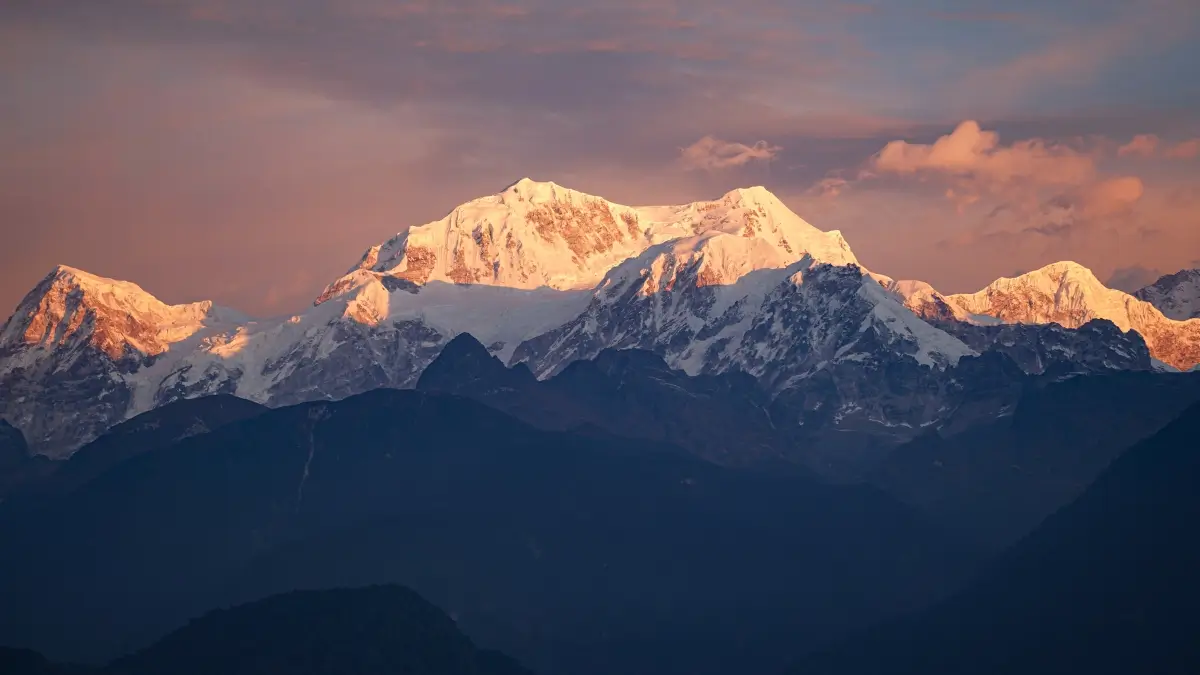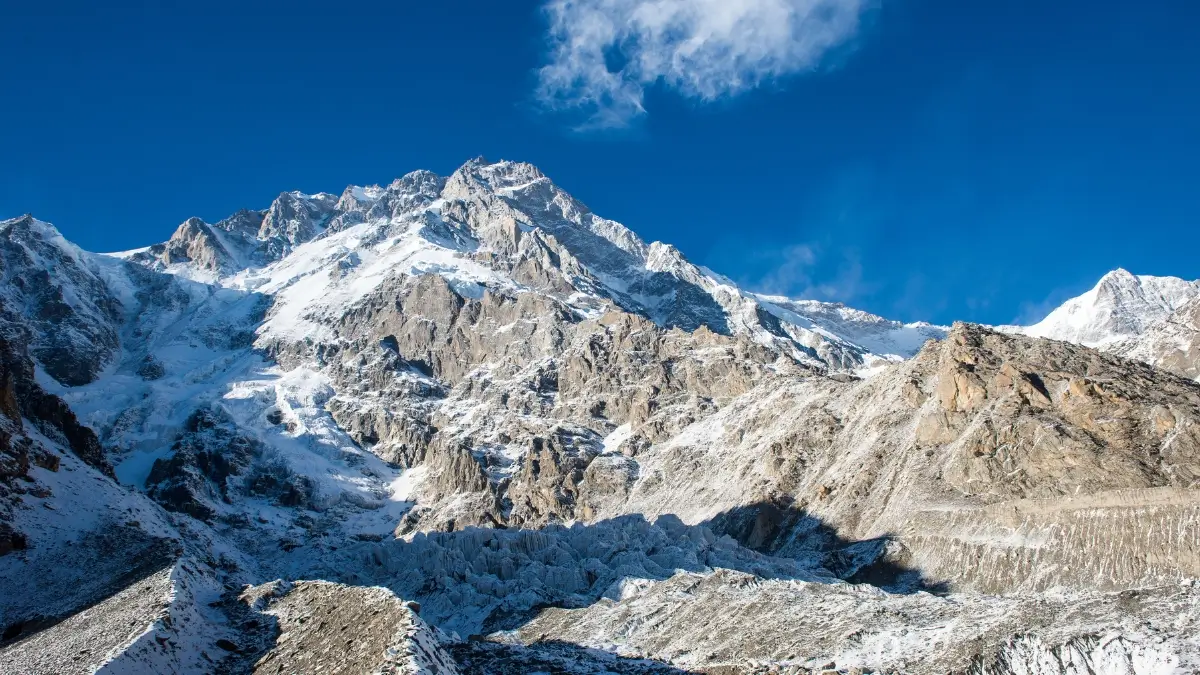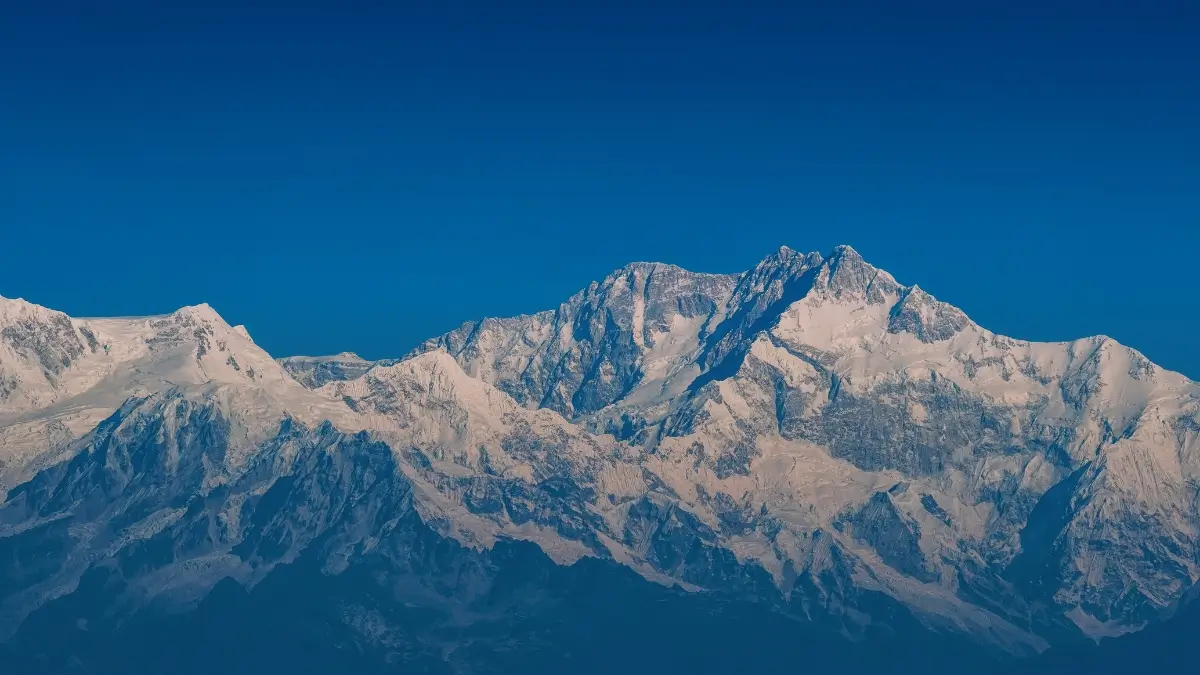South Asia is home to some of the world’s most majestic mountains. Across countries like Nepal, India, Bhutan, Pakistan, and Myanmar, these peaks shape landscapes, cultures, and high‑altitude adventure tourism. As the dominant range, the Himalayas define this region’s topography, and Nepal stands at the epicenter of trekking and mountaineering.
The most well-known mountains and mountain ranges in South Asia are covered in this interesting blog, which is ideal for hikers, climbers, and inquisitive tourists.
Tallest Mountains in South Asia
You've probably heard of Mount Everest, but South Asia's towering peaks extend far beyond just the world's highest mountain.
South Asia region is home to dozens of other giants that rival Everest in beauty and challenge, yet remain relatively unknown to the outside world.
These aren't just geographical features on maps: they're living monuments that have shaped cultures and challenged adventurers for generations. Each peak tells its own story that tests the world's best mountaineers to trekking adventures that welcome determined hikers ready for high-altitude challenges.
1. Mount Everest - 8,848.86 m

Mount Everest isn't just the world's tallest mountain; it's the peak that captures imaginations worldwide. Known as Sagarmatha in Nepal and Chomolungma in Tibet, this legendary giant holds deep spiritual meaning for local communities.
The trek to Everest Base Camp brings thousands of everyday adventurers face-to-face with the world's most famous mountain. The energy there is incredible, adventurers from around the globe sharing that same mix of excitement and disbelief at actually being there. Pushing your boundaries is difficult enough, but ambitious individuals who are well-prepared can still succeed. The combination of incredible achievement and achievable adventure is perfect for Everest Base Camp, whether you're planning or just dreaming.
Ready to stand in the shadow of the world’s highest peak? Remember Nepal Gateway Trekking for your Everest journey.
2. K2 - 8,611 m
K2 stands as the world's second-highest mountain, but don't let that "second place" fool you. Among serious climbers, K2 has earned a reputation that makes Everest look almost welcoming by comparison.
Tucked away in Pakistan's remote Karakoram range, K2 doesn't just challenge climbers, it eliminates them. For every four people who successfully reach K2's summit, one doesn't make it back down alive. That's a fatality rate that makes even the most experienced mountaineers pause and think twice. This is why K2 has earned its nickname "The Savage Mountain" a title that isn't meant to sound dramatic, but rather serves as a stark warning. K2 is still firmly in the domain of top professional climbers who have spent years, perhaps decades, training for its particular challenges, in contrast to other big peaks that are now reachable by eager amateurs.
3. Kanchenjunga – 8,586 m

The third-highest peak, Kanchenjunga, which shares a border with India and Nepal, is rooted in the mighty Himalayas. Its ability to remain mostly unaffected by mass tourism is what really sets Kanchenjunga apart. Thousands of trekkers visit other big Himalayan peaks every year, but Kanchenjunga is still incredibly untamed. Access is restricted by stringent procedures put in place by the local Sikkimese and Nepalese communities, guaranteeing that anyone who visits will do so with true respect for the mountain's natural surroundings and its deep spiritual significance.
If you're looking for an experience that combines incredible natural beauty with deep cultural significance, all while supporting communities that have chosen preservation over profit, Kanchenjunga represents exactly what responsible mountain adventure should look like. Take Kanchenjunga Base Camp trek and witness the beauty of third highest mountain.
4. Lhotse – 8,516 m
Just south of Everest, Lhotse shares the same base camp but often hides in Everest’s shadow. Even for seasoned mountaineers, its intimidating south face, one of the highest in the Himalayas, offers a challenging technical climb. They are aware that living in the shadow of Everest is not the only difficult task that Lhotse provides. In climbing circles, the south face of the mountain is famous. It is a huge wall of rock and ice that is so steep that it is regarded as one of the hardest climbs in the whole Himalayan range. You don't approach this mountain lightly, even if you've climbed other 8,000-meter peaks before.
5. Makalu – 8,485 m
There's something almost architectural about Makalu that sets it apart from other Himalayan giants. Visible from afar by its pyramid-shaped summity, you can spot Makalu's distinctive silhouette from incredible distances that sharp, triangular peak cutting into the sky like a massive stone monument.
Makalu sits in splendid isolation, far from the well-traveled routes and established infrastructure that make other 8,000-meter peaks more accessible. Getting to Makalu is an adventure in itself, requiring a serious commitment to remote wilderness travel before you even start thinking about the technical climbing ahead. Serious ice-climbing abilities and the kind of meticulous planning that comes from years of mountaineering expertise are required for the routes. This is not a place for wealthy amateurs to take shortcuts or go on guided adventures. Makalu demands that you give every facet of alpine climbing your all.
Nepal Gateway Trekking offers affordable and stunning Makalu Base Camp Trek for trekkers who are thinking of exploring Makalu region.
6. Cho Oyu – 8,188 m

Regarded as the most accessible of the 8,000‑meter peaks, Cho Oyu serves as a popular acclimatization climb for expeditions heading to Everest or Lhotse. Its routes are relatively straightforward, and the views from Everest to the Nangpa La pass are panoramic and unforgettable. It is suitable for beginner mountaineers.
7. Dhaulagiri I – 8,167 m
On the well-known Annapurna Circuit trek, there comes a point at which you turn a corner, glance up, and realize why the locals called this majestic peak "Dhaulagiri," which translates to "White Mountain." Rising to 8,167 meters with brilliant snow-covered cliffs that seem to glow against the sky, Dhaulagiri I is one of those mountains that stops trekkers dead in their tracks, cameras clicking frantically as they try to capture something that's almost too spectacular to believe.
While it may look serene and beautiful from the trekking routes below, this mountain is absolutely unforgiving to anyone who dares to climb it. The climbing here requires serious technical skills, perfect physical conditioning, and the kind of mental toughness that only comes from years of high-altitude mountaineering experience.
8. Manaslu – 8,163 m
Surrounded by serene, Tibetan‑influenced villages and high‑altitude monasteries, Manaslu has become a rising star among trekkers seeking solitude and cultural immersion. It’s often viewed as a “pre‑Everest” expedition, offering serious terrain without the crowd.
The climbing here is no joke. Like all 8,000-meter peaks, Manaslu requires respect, technical skill, and appropriate acclimatization. Manaslu represents exactly what high-altitude travel should be: challenging, transforming, and deeply meaningful for those seeking adventure that feeds both the soul and the spirit of discovery.
Not quite ready for Everest, but still want a true expedition experience? Manaslu Circuit Trek is perfect for ambitious trekkers seeking solitude.
9. Nanga Parbat – 8,126 m

Nanga Parbat is a summit that is revered in a completely different way. This enormous behemoth, which rises to a height of 8,126 meters on Pakistan's western border, did not acquire the moniker "Killer Mountain" by dramatic narrative or advertising hype. Whole crews perished in avalanches, bad weather, and the harsh terrain of Nanga Parbat during the early expeditions. This peak consistently claimed lives, making it legendary for all the wrong reasons, and for years, it appeared to deliberately thwart human attempts to reach its top.
What makes this mountain so formidable becomes clear when you understand its most notorious feature: the Rupal Face. A wall of rock, ice, and snow that rises over 4,600 meters of nearly vertical exposure that's taller than most entire mountain ranges, condensed into a single, terrifying cliff face. It's considered one of the largest mountain faces on Earth, and looking up at it from the base is an experience that humbles even the most confident climbers.
10. Annapurna I – 8,091 m
The first 8,000-meter peak to be climbed was Annapurna I in 1950, and it is still regarded as one of the most dangerous due to its high death rate. In addition to reaching the top of another peak, French climbers Maurice Herzog and Louis Lachenal addressed one of the most important problems in exploration when they arrived at the summit in 1950: could humans truly ascend these impossibly large mountains and survive?
That historic first ascent opened the door to the golden age of Himalayan climbing, inspiring the expeditions that would eventually conquer Everest and all the other 8,000-meter peaks. In many ways, modern high-altitude mountaineering owes its existence to what happened on Annapurna's slopes over 70 years ago.
Each year, thousands of explorers enter one of the world's most breathtaking mountain amphitheaters on the Annapurna Sanctuary Trek. With views that most people only see in pictures, trekkers may sleep in the sanctuary surrounded by towering peaks and get up close and personal with the base of this ancient behemoth.
Looking for a scenic, soul-stirring trek with rich history? The Annapurna Base Camp Trek awaits.
Major Mountain Ranges in South Asia

When you think about the world's most spectacular mountain ranges, South Asia doesn't just compete, it completely dominates the conversation. This region is home to some of the most dramatic and diverse mountain systems on our planet, each with its own personality, challenges, and incredible stories to tell.
The remarkable diversity of the mountain ranges in South Asia is what makes them so unique. From the imposing Himalayan giants that reach heights of over 8,000 meters to the difficult technical difficulties of the Karakoram to ranges that provide more approachable yet no less breathtaking trekking experiences, you've got it all. Every range has its own distinct culture, climbing customs, and adventure possibilities.
Understanding these major mountain ranges gives you insight into some of the most breathtaking geography our planet has to offer, whether you're a Trekker seeking amazing high-altitude adventures, a serious mountaineer searching for your next extreme challenge, or just someone who enjoys learning about the natural wonders that shape our world.
These mountains are living, breathing ecosystems that never cease to amaze, challenge, and change everyone who sees them. They are more than just striking numbers on paper. Let's take a look at the ranges that make South Asia the indisputable epicenter of adventure at high altitudes.
Himalayas
Stretching through Nepal, India, Bhutan, and Tibet, the Himalayas hold the planet’s highest peaks, including Everest, Kanchenjunga, and Lhotse. Nepal especially, is built around well‑maintained trekking infrastructure with teahouses, clear permit systems, and supportive communities.
Karakoram
Home to K2 and several towering 8,000‑meter peaks, the Karakoram Range lies mainly in northern Pakistan. It’s more remote and less trodden by mass tourism, meaning logistics are challenging and the adventure is raw.
Hindu Kush
Running across Afghanistan and northwest Pakistan, the Hindu Kush is rich in history and geography but not a principal trekking destination. It served as a historic crossroads, now known for rugged high landscapes and remote valleys.
Western & Eastern Ghats
Found along the western and eastern coastal plains of India, these ranges are lower in elevation but extremely rich in biodiversity. They're ideal for nature lovers and eco‑trekkers rather than high‑altitude mountaineers.
Arakan Yoma
The Arakan Yoma range in Myanmar is a relatively new tourist destination. Although it lacks Nepal's or Pakistan's high peaks and well-traveled paths, it offers forested hills, isolated scenery, and cultural knowledge.
Trekking & Adventure: Why Nepal Leads the Way?
Nepal is a location where adventure fantasies come true, not simply another trekking destination. This tiny Himalayan country has produced something quite remarkable: the ideal fusion of breathtaking alpine landscapes, genuine cultural encounters, and advanced infrastructure that enables common people to embark on seemingly unachievable excursions. Not only does Nepal boast the tallest mountains in the world, but the entire nation, from the renowned Sherpa hospitality to the network of mountain lodges, seems to be built around assisting regular explorers in accomplishing extraordinary feats.
No matter your level of experience, Nepal offers a special fusion of authenticity and accessibility that transforms dream destinations into realistic objectives.
Nepal’s status as the premier trekking and climbing destination in South Asia is no accident:
- Altitude & Accessibility: You’ll find all the top 8,000 m peaks within Nepal or its bordering zones.
- Flexible Trek Durations: From weekend treks to multi‑week expeditions, Nepal offers something for every level.
- Logistical Ease: Teahouse routes, well‑managed permits, local support networks, and seasoned guides make Nepal trekking smooth.
- Global Reputation: The country’s over half-century history of mountain tourism makes it both safe and trusted by travelers worldwide.
Nepal has everything you need to turn your trekking dreams into reality, whether it’s your first high-altitude trail or your tenth.
Contact Nepal Gateway Trekking for your next himalayn advanture.
FAQs
Which countries have the most famous mountain ranges in South Asia?
Nepal (Himalayas), Pakistan (Karakoram & western Himalaya), India and Bhutan (eastern Himalayas), plus Myanmar (Arakan Yoma) and Afghanistan (Hindu Kush).
Can beginners trek in the Himalayas?
Yes, many beginner‑friendly routes exist, such as the Annapurna Base Camp or Everest Base Camp trails, especially in Nepal.
Do I need a guide or permit to trek in South Asia?
Yes. Most high‑altitude trails require government permits and registered guides or porter support, especially near peaks or border zones.
What gear is essential for mountain trekking in this region?
Warm layering, waterproof hiking boots, a sleeping bag rated to −10 °C or lower, trekking poles, a first aid kit, and altitude medication if required.
Are the mountains in South Asia safe for solo trekkers?
Popular lower‑level trekking routes offer good safety for solo trekkers. But high‑altitude or remote trails should be done with experienced guides or teams.
How does trekking in Nepal compare to other South Asian countries?
Nepal boasts superior infrastructure, easier permit access, and a range of trail options for all ability levels, making it unrivaled by other countries in the region.
What is the best time of year to trek in Nepal?
Spring (March to May) and fall (September to November) are the ideal seasons because of the consistent weather, bright skies, and breathtaking sights.




